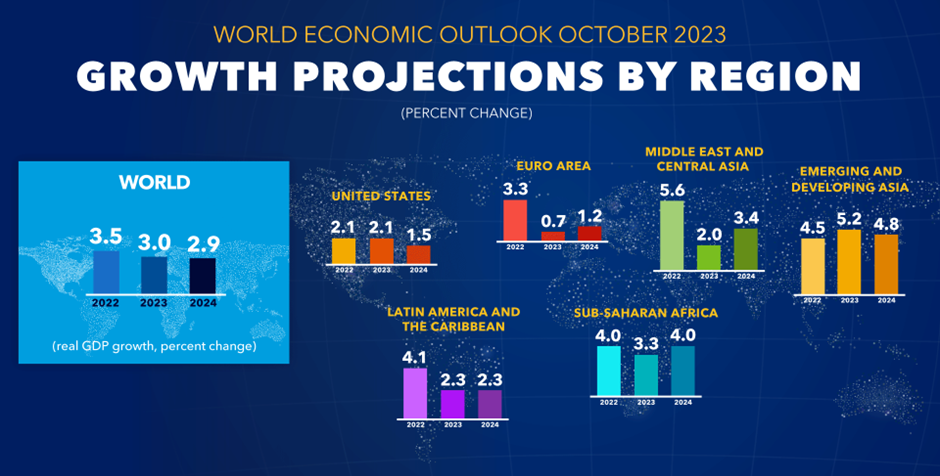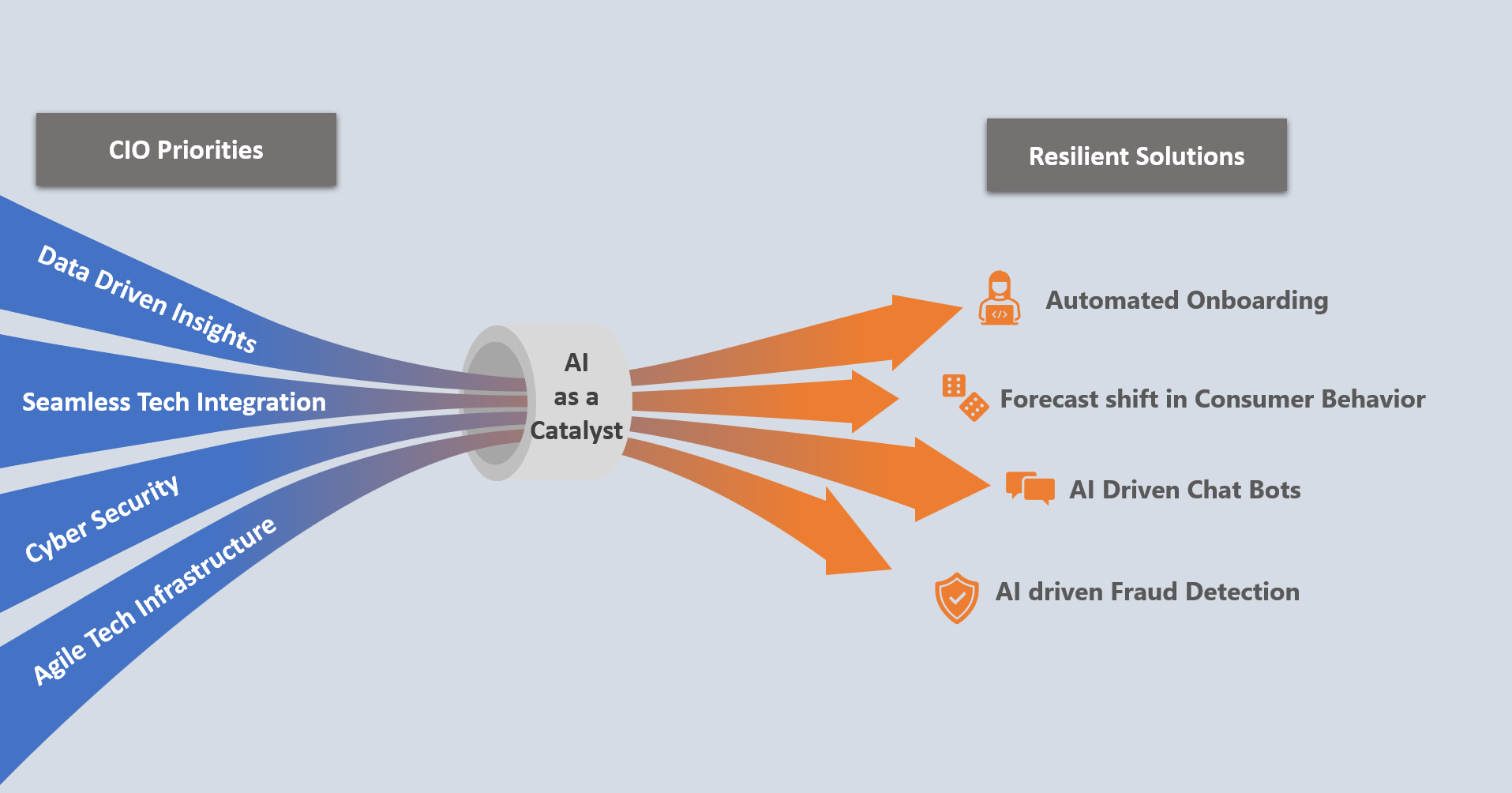Customer Acquisition in Banking is Becoming a CIO’s Problem; How Can AI Address This?
As the shadow of an impending global economic slowdown looms, the role of Chief Information Officers (CIOs) in banking has become even more pivotal. Traditionally confined to marketing and sales, the urgency of securing new customers has permeated the CIO’s agenda due to the transformative potential of AI.
This blog explores the unfolding landscape, drawing parallels with the past, emphasizing the urgency for CIOs to address customer acquisition challenges, and highlighting how artificial intelligence (AI) can be the beacon of hope in navigating through uncertain times, placing CIOs at the forefront of the battle for survival.
What financial trends does the IMF anticipate for 2024?
According to the most recent World Economic Outlook, advanced economies have experienced a downward trend for the past three years. The current geopolitical instabilities, ongoing conflicts in key regions like Europe and the Middle East, and tensions in South Asia have led to heightened inflation and sluggish economic growth.
The overall economic surge observed in the aftermath of the Covid period has markedly diminished, reducing demand across advanced economies. This downturn is directly and significantly affecting the banking sector.

Source: Navigating global divergences, World Economic Outlook, October 2023:
https://www.imf.org/en/Publications/WEO/Issues/2023/10/10/world-economic-outlook-october-2023
What have we witnessed in the past?
The last major global banking crisis, commonly referred to as the “Financial Crisis of 2007–2008” or the “Global Financial Crisis (GFC),” was triggered by a combination of factors, including the collapse of the subprime mortgage market in the United States, a housing bubble, excessive risk-taking by global financial institutions, and a lack of adequate regulatory oversight. The repercussions of this crisis were felt worldwide, leading to severe economic downturns in various countries and prompting significant regulatory and policy changes in the financial sector.
What did we learn from the last banking crisis?
“History is a great teacher; learn from the past, live in the present, and shape the future.”
The scars of the last banking crisis are still fresh in the collective memory, serving as a stark reminder of the vulnerabilities inherent in the financial sector. During that tumultuous period, CIOs played a critical role in managing the fallout, learning invaluable lessons applicable in the face of the looming recession.
Why customer acquisition is important for CIOs now?
Data-driven insights from crisis management
The last banking crisis emphasized the importance of data-driven decision-making. CIOs, having navigated the complexities of crisis management, understand the pivotal role data plays in analyzing customer behavior and market dynamics during economic downturns. Leveraging these insights becomes crucial in developing strategies for customer acquisition amidst uncertainty.
Integration as a pillar of resilience
The banking crisis highlighted the vulnerabilities in siloed systems. CIOs emerged as architects of integration, ensuring seamless collaboration between departments to weather the storm. As the threat of another recession looms, CIOs must revisit and reinforce the integration efforts to fortify the organizational structure for effective customer acquisition strategies.
Cybersecurity as a non-negotiable safeguard
The last banking crisis exposed vulnerabilities not only in financial systems but also in cybersecurity measures. Having navigated the heightened threat landscape during the crisis, CIOs now prioritize cybersecurity as a non-negotiable safeguard. The impending recession underscores the need for robust cybersecurity measures to protect customer trust and financial assets.
Adapting to economic contractions
The last banking crisis demonstrated the necessity for adaptability. Having weathered the storm, CIOs are well-versed in steering organizations through economic contractions. The ability to adapt technology infrastructure to match the evolving needs of the business is a skill that will once again be tested in the face of an impending recession.
Why is AI a catalyst for resilient customer acquisition strategies?
![]() Automated onboarding for operational efficiency
Automated onboarding for operational efficiency
The last crisis prompted a reevaluation of operational efficiency. AI’s role in automating customer onboarding processes, having proven its worth in streamlining operations, becomes an asset for CIOs looking to enhance efficiency amidst the impending recession. Automated onboarding, particularly successful in emerging economies like India, not only speeds up processes but also lowers costs, providing a strategic advantage.
![]() Drawing parallels with predictive analytics
Drawing parallels with predictive analytics
In the aftermath of the last banking crisis, predictive analytics emerged as a tool for anticipating market trends. CIOs, having witnessed the power of predictive analytics, can leverage AI to draw parallels with historical data and forecast potential shifts in customer behavior during economic downturns. Adopting predictive AI has proven instrumental in reducing Non-Performing Assets (NPAs) for major banks in emerging economies like India. This foresight is invaluable in crafting resilient customer acquisition strategies.
![]() Enhanced customer support through chatbots
Enhanced customer support through chatbots
The last crisis underscored the need for efficient customer support. AI-driven chatbots, having proven their mettle during the crisis aftermath, now stand as pillars of enhanced customer engagement. CIOs can integrate chatbots seamlessly into customer acquisition processes, providing efficient and personalized support even during economic uncertainty.
![]() Fraud detection reinforced by AI
Fraud detection reinforced by AI
The last banking crisis witnessed an upsurge in financial fraud. CIOs, having addressed the vulnerabilities, can deploy AI-driven fraud detection systems to reinforce financial resilience. As economic uncertainty grows, these systems become vital in safeguarding customer transactions and maintaining trust in digital interactions.

AI as a catalyst to drive a bank’s CIO priorities
Conclusion: Navigating the current storm with insights from the past
As we stand on the brink of another economic downturn, the echoes of the last banking crisis provide valuable insights for CIOs in addressing customer acquisition challenges. The role of AI as a catalyst for resilient strategies cannot be overstated. Drawing from their crisis management experiences, CIOs are well-positioned to lead organizations through the uncertain terrain of economic contractions.
In conclusion, the convergence of economic uncertainty and customer acquisition challenges resonates with the lessons learned from the last banking crisis. CIOs, armed with the strategic resilience developed through navigating past challenges, now have an opportunity to shape the future of banking in the face of impending recession. Embracing AI is not just an innovation; it’s a strategic continuation of the journey towards a more resilient and adaptive banking ecosystem. As stewards of technology, CIOs have the responsibility to leverage AI, drawing from the lessons from the past, to redefine the landscape of customer acquisition and ensure that financial institutions emerge stronger from the echoes of the impending storm.
Latest Blogs
Core banking platforms like Temenos Transact, FIS® Systematics, Fiserv DNA, Thought Machine,…
We are at a turning point for healthcare. The complexity of healthcare systems, strict regulations,…
Clinical trials evaluate the efficacy and safety of a new drug before it comes into the market.…
Introduction In the upstream oil and gas industry, drilling each well is a high-cost, high-risk…




